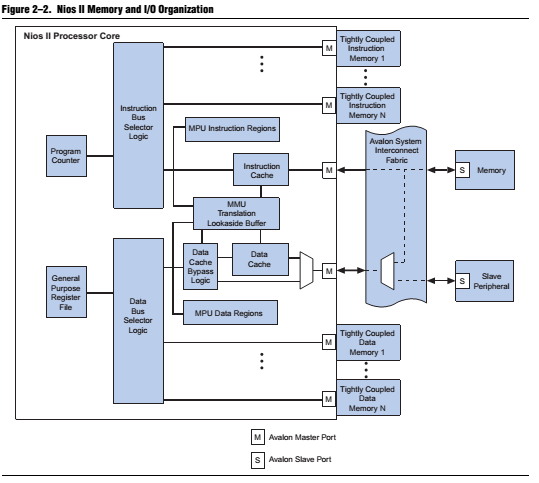Memory an I/O
(参考资料:Nios II processor reference handbook)
灵活
The flexible nature of the Nios II memory and I/O organization are the most notable difference between Nios II processor systems and traditional microcontrollers.Because Nios II processor systems are configurable, the memories and peripherals vary from system to system. As a result, the memory and I/O organization varies from system to system.
访问方式
A Nios II core uses one or more of the following to provide memory and I/O access:
■ Instruction master port—An Avalon® Memory-Mapped (Avalon-MM)
master port
that connects to instruction memory via system interconnect fabric
■ Instruction cache—Fast cache memory internal to the Nios II core
■ Data master port—An Avalon-MM master port that connects to data memory and
peripherals via system interconnect fabric
■ Data cache—Fast cache memory internal to the Nios II core
■ Tightly-coupled instruction or data memory port—Interface to fast on-chip
memory outside the Nios II core
The Nios II architecture handles the hardware details for the
programmer, so
programmers can develop Nios II applications without specific knowledge of the
hardware implementation.

Instruction and Data Buses 指令和数据总线
关键词:哈佛结构
The Nios II architecture supports separate instruction and data
buses, classifying it as a Harvard architecture. Both the instruction and
data buses are implemented as Avalon-MM master ports that adhere to the
Avalon-MM interface specification. The data master port connects to both memory
and peripheral components, while the
instruction master port connects only to memory components.
Memory and Peripheral Access 内存和外部设备的访问
关键词:统一地址空间
The Nios II architecture provides memory-mapped I/O access. Both data
memory
and peripherals are mapped into the address space of the data master port.
The
Nios II architecture uses little-endian byte ordering.
Words and halfwords are stored in memory with the more-significant bytes at
higher addresses.
The Nios II architecture does not specify anything about the
existence of memory and peripherals; the quantity, type, and connection of
memory and peripherals are
system-dependent. Typically, Nios II processor systems contain a mix of fast
on-chip memory and slower off-chip memory. Peripherals typically reside on-chip,
although interfaces to off-chip peripherals also exist.
Instruction Master Port
The Nios II instruction bus is implemented as a 32-bit Avalon-MM master port.
The
instruction master port performs a single function: it fetches instructions to
be
executed by the processor. The instruction master port does not perform any
write
operations.
Data Master Port
The Nios II data bus is implemented as a 32-bit Avalon-MM master port. The data
master port performs two functions:
■ Read data from memory or a peripheral when the processor executes a load
instruction
■ Write data to memory or a peripheral when the processor executes a store
instruction
Cache Memory
The Nios II architecture supports cache memories on both the instruction master
port(instruction cache) and the data master port (data cache). Cache memory
resides on-chip as an integral part of the Nios II processor core. The cache
memories can improve the average memory access time for Nios II processor
systems that use slow off-chip memory such as SDRAM for program and data
storage.
The instruction and data caches are enabled perpetually at run-time, but
methods are provided for software to bypass the data cache so that peripheral
accesses do not return cached data. Cache management and cache coherency are
handled by software.The Nios II instruction set provides instructions for cache
management.
例子:在实时采集图像数据时,要写入文件中,但是为了避免突然掉电带来的数据损失,需要将数据直接写到硬盘文件中。
Tightly-Coupled Memory
Tightly-coupled memory provides guaranteed low-latency memory access for
performance-critical applications. Compared to cache memory, tightly-coupled
memory provides the following benefits:
■ Performance similar to cache memory
■ Software can guarantee that performance-critical code or data is located in
tightly-coupled memory
■ No real-time caching overhead, such as loading, invalidating, or flushing
memory
Physically, a tightly-coupled memory port is a separate master port on the Nios
II
processor core, similar to the instruction or data master port. A Nios II core
can have zero, one, or multiple tightly-coupled memories. The Nios II
architecture supports tightly-coupled memory for both instruction and data
access. Each tightly-coupled memory port connects directly to exactly one memory
with guaranteed low, fixed latency. The memory is external to the Nios II core
and is located on chip.
Address Space and Memory Partitions
The MMU provides a 4-GB(why) virtual address space, and is
capable of addressing up to 4 GB of physical
memory.
The 4-GB virtual memory space is divided into partitions. The
upper 2 GB of memory is reserved for the
operating system and the lower 2 GB is reserved for user processes.
